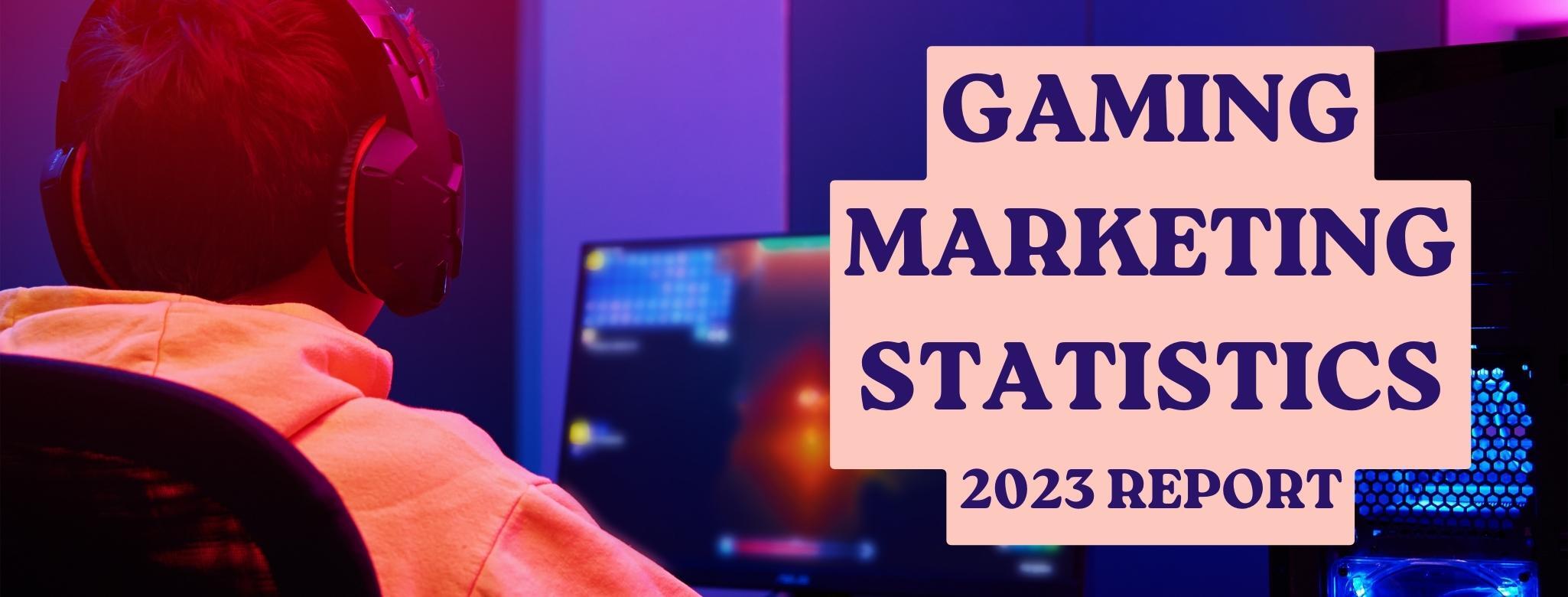
20 May GAMING MARKETING STATISTICS IN 2023
To say that the gaming industry is booming would be a massive understatement. The video game industry’s revenue is currently higher than any other in the entertainment sector. In 2020, it was valued at $159 billion and is projected to reach $200 billion by 2023. According to a recent report, the number of gamers worldwide is expected to surpass 3 billion by the end of 2022. This represents a significant increase from the 2.5 billion gamers that were reported in 2017. The report also found that 65% of U.S. citizens play video games on a daily basis while 57% of gamers in the United States play video games on their smartphones. It looks like these trends are being driven by the popularity of mobile and online games, as well as the increasing availability of affordable gaming hardware. Whether it is PC gaming, consoles, or the mobile market, it seems like there is no better time to get into the gaming industry than right now.
Below, we highlight 25 key gaming marketing statistics:
Gaming Marketing Statistics (Editors Choice)
- There are 3 billion gamers worldwide in 2022
- 65% of U.S. Citizens play games daily
- Free-to-play games earned 80% of the total digital games revenue in 2021
- 74% of the U.S. mobile gamers would watch an in-game ad if they get an in-app perk in return
- Influencer marketing in gaming is forecast to reach $4.4 billion in 2022
- 81% of media buyers want to increase their in-game advertising spend over the next 12 months.
Gaming Marketing: 25 Top Gaming Marketing Statistics in 2023!
Gaming Marketing Statistics #1: In 2022, video game advertising spending in the United States reached 5.8 billion U.S. dollars.
According to the latest data from Statista, in 2022, video game advertising spending in the United States was forecast to amount to 5.8 billion U.S. dollars. This would constitute an increase of more than 14 percent compared to the value of five billion reported in 2021. The increase in spending is due to the growing popularity of video games and the rise of e-sports. Over the past few years, there has been a boom in the video game industry, with new titles and platforms constantly emerging. At the same time, e-sports have become increasingly popular, with major tournaments being broadcast on television and attracting huge audiences. As a result, advertisers are eager to reach these consumers, and spending on video game advertising is forecast to grow in the coming years.

Gaming Marketing Statistics #2: The United States in-game advertising market accounted for $2,2 billion in revenue in 2021.
Research Dive’s report on the North American in-game advertising market states that the revenue in 2021 was $2,2 billion and is projected to register a revenue of $8,7 billion by 2028. The market is growing at a CAGR of 16.5% from 2021 to 2028. North America is one of the largest in-game advertising markets due to investments in online advertising. This, in turn, influences the demand for online advertising services from companies. Aside from that, brands are now investing in advertisements on social media platforms and gaming applications due to a vast gaming community. The advertising landscape in North America is continually changing, with new drifts and technologies coming into play. However, ResearchDive believes that the market will continue to grow steadily in the coming years with the right strategies in place.
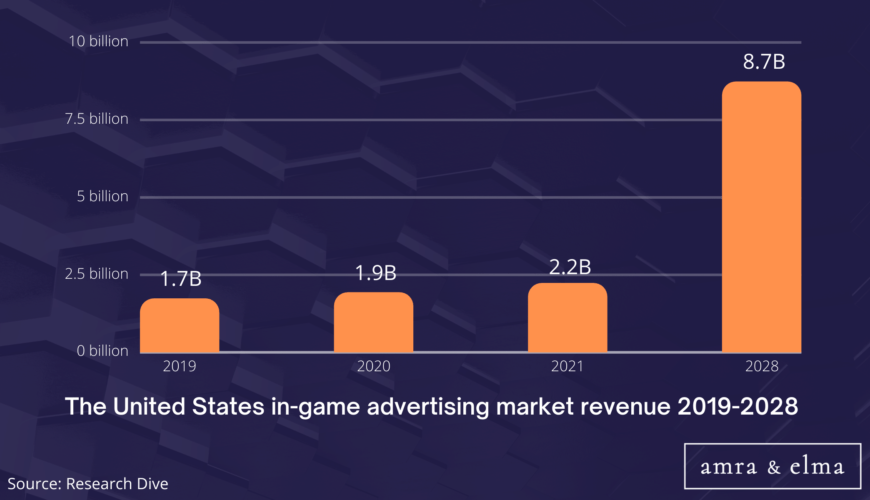
Gaming Marketing Statistics #3: 57% of gamers in the United States play video games on their smartphone.
A February 2021 survey by Statista found that 57 percent of gamers in the United States played video games on their smartphone. Smartphones ranked first among preferred gaming devices, with gaming consoles and PCs claiming the second and third spot. The survey also found that 64 percent of respondents believed that smartphones were the most convenient gaming device, while 62 percent agreed that they were the most affordable option. With the advent of cloud gaming services such as Google Stadia and Microsoft xCloud, the popularity of mobile gaming will likely continue to grow in the coming years.
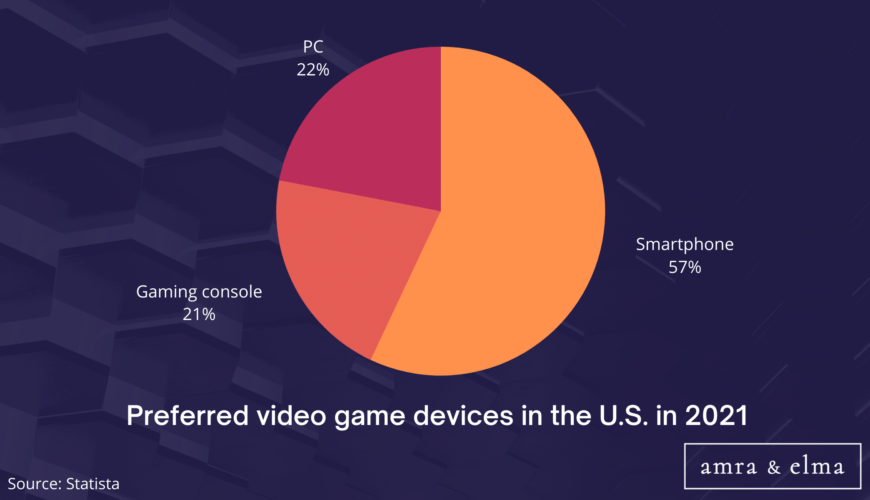
Gaming Marketing Statistics #4: 65% of U.S. Citizens play video games daily.
A recent study by the ESA found that 65% of Americans play video games daily. That is an impressive figure, but it is even more impressive when considering how much time people spend on gaming. Americans spend an average of seven hours a week playing with others online and six more hours playing with others in person. That comes out to 13 hours a week, or nearly two hours a day. Furthermore, that is just the average; many people spend even more time gaming. With such a large portion of the population involved in gaming, it is no surprise that the industry is booming. Video games are becoming more and more popular, and developers are increasingly focusing on creating games that everyone can enjoy.

Gaming Marketing Statistics #5: 74% of the United States mobile gamers would watch an in-game ad if they get an in-app perk in return.
A new mobile gaming industry report from BusinessOfApps.com has found that 74% of mobile gamers in the United States would be willing to watch an in-game ad in return for an in-app perk. The report surveyed 2,000 mobile gamers and found that in-game advertising is seen as an acceptable trade-off by most gamers, with 68% saying they had no issue with ads as long as they did not interfere with gameplay. Interestingly, the report also found that younger gamers were more tolerant of ads, with 80% of 18-24-year-olds saying they would be willing to watch an ad for an in-app perk. These findings suggest that the mobile gaming industry is ripe for growth in terms of in-game advertising revenues.
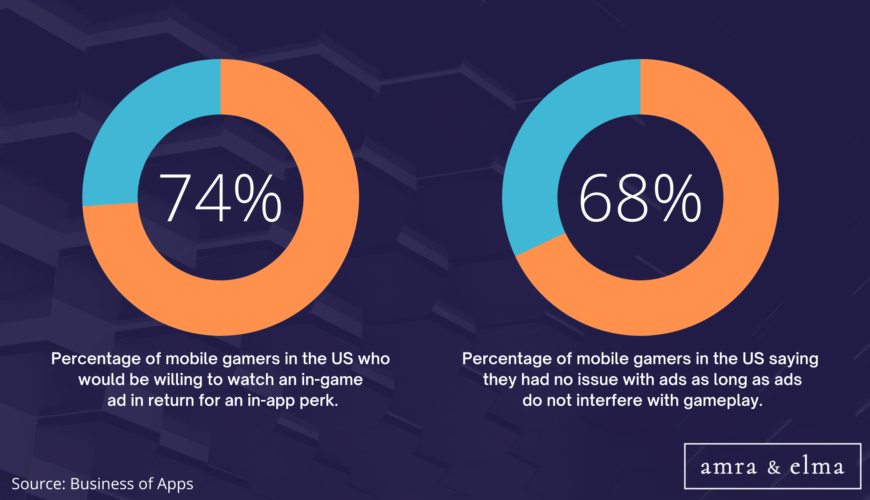
Gaming Marketing Statistics #6: 82% of mobile gamers prefer free mobile games with ads to paid mobile games without ads.
When it comes to mobile gaming, free games with ads are still the favorite among players. According to a mobile gaming trends survey by BusinessOfApps.com, 82% of respondents prefer free games with ads to paid games without ads. This is likely because mobile gamers are used to seeing ads in other contexts, such as on social media or while streaming video content. In addition, free games with ads tend to be more widely available and easier to access than paid games, which may require a purchase or subscription. For many mobile gamers, the convenience and accessibility of free games with ads outweigh any potential discomfort from the ads themselves.
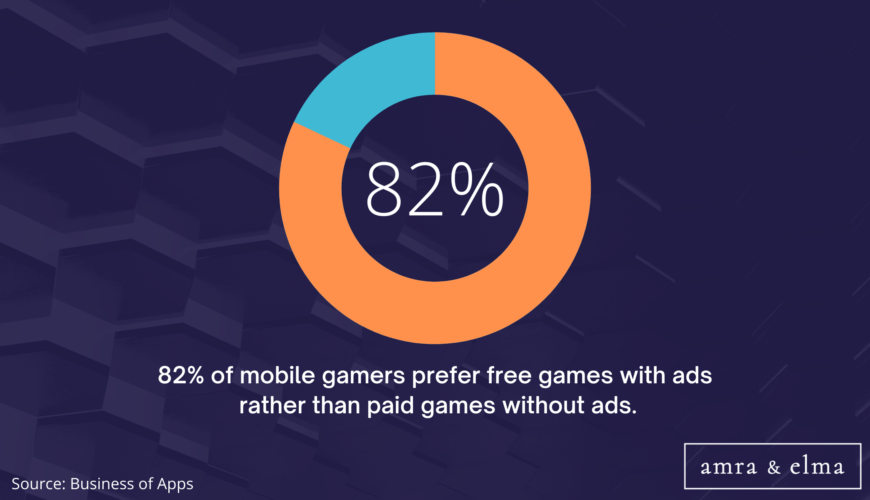
Gaming Marketing Statistics #7: 3 out of 5 U.S. gamers said they prefer to download games for free.
According to a survey by Morning Consult, gamers are most likely to download games for free. Roughly 3 in 5 gamers said they download games for free. However, if they have to pay, they are more likely to buy them online (62 percent) than to purchase a hard copy (28 percent). Fewer than 10 percent of gamers rent either virtual or physical copies of games, a method that was once popular at brick-and-mortar stores like Blockbuster in the 1990s. This is likely due to the convenience of online shopping and the increasing popularity of digital downloads. Gamers are also more likely to purchase game add-ons and DLC (downloadable content) than buy new games. This might suggest that gamers are becoming more accustomed to spending small amounts of money regularly rather than making large upfront purchases.
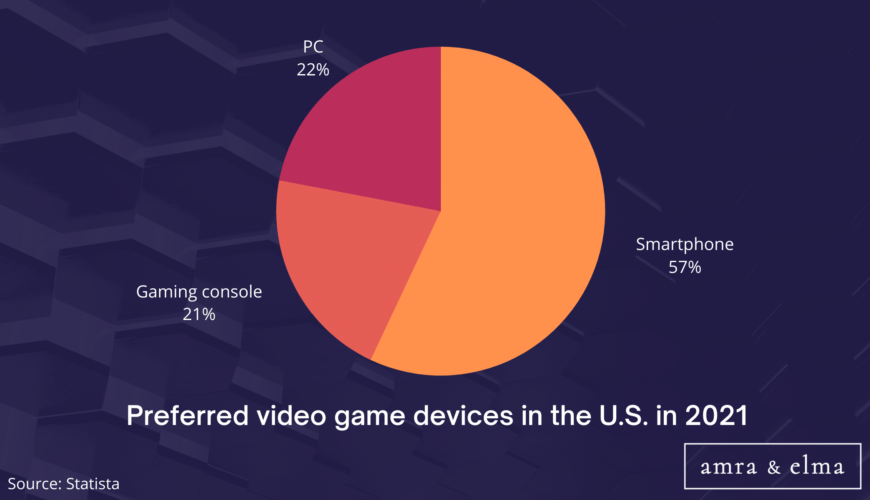
Gaming Marketing Statistics #8: Free-to-play games earned 80% of the total digital games revenue in 2021.
According to the data by Venture Beat, free-to-play games earned 80% of the total digital games revenue in 2021. The total global free-to-play game market in 2021 was worth $75.6 billion. That is impressive if we consider the word “free” in it. Asia’s gamers were responsible for 62% of this enormous amount. The main game to blame is Fortnite, which drastically increased the free-to-play console games with its 458% growth year on year. According to the same source, the amount of people who subscribe to Xbox Live Gold has increased by 5 million since the introduction of Fortnite’sFortnite’s Battle Royale mode. So, even though gamers do not have to spend any money to play Fortnite, the developers are still making a huge profit. That is just one example of a free-to-play game on one console. Overall, it is no wonder that these types of games took over the market by storm.

Gaming Marketing Statistics #9: In 2021, total U.S. consumer spending on video game content amounted to 51.69 billion U.S. dollars.
According to new data released by the Entertainment Software Association (ESA), in 2021, total U.S. consumer spending on video game content amounted to a record 51.69 billion U.S. dollars, a significant increase from the 48.12 billion U.S. dollars in the preceding year. Video game spending surged in 2020 due to the COVID-19 pandemic, as people sought new ways to entertain themselves while stuck at home. The pandemic also led to increased gaming consoles and accessories sales, as people looked for ways to upgrade their at-home gaming experience. With more people than ever before playing video games, it is no surprise that spending on game content has reached an all-time high. Moreover, with the next generation of consoles released later this year, spending will likely continue to rise in the coming years.
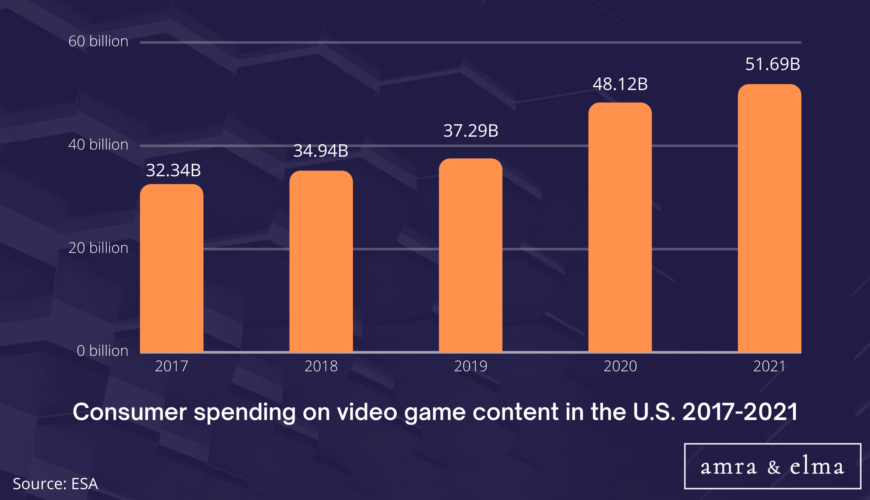
Gaming Marketing Statistics #10: In 2021, North American gamers spending on loot boxes and in-game currency packs amounted to $4.5 billion.
According to Statista, in 2022, North American gamer spending on loot boxes and in-game currency packs is projected to increase by 21.6 percent compared to the previous year. Currently, the annual loot box market value in North America is estimated at 4.5 billion U.S. dollars and is set to surpass 5.2 billion U.S. dollars in 2025. Loot boxes are a type of microtransaction where players can pay for randomized virtual items. These items can improve a player’s game experience or give them an edge over others who have not purchased loot boxes. In-game currency packs can be used to purchase virtual items or cosmetics within a game. The growing popularity of loot boxes and in-game currency packs is driven by the increased prevalence of free-to-play games and the appeal of collecting rare or exclusive items. As the gaming industry grows, the market for loot boxes and in-game currency packs will likely continue to expand.
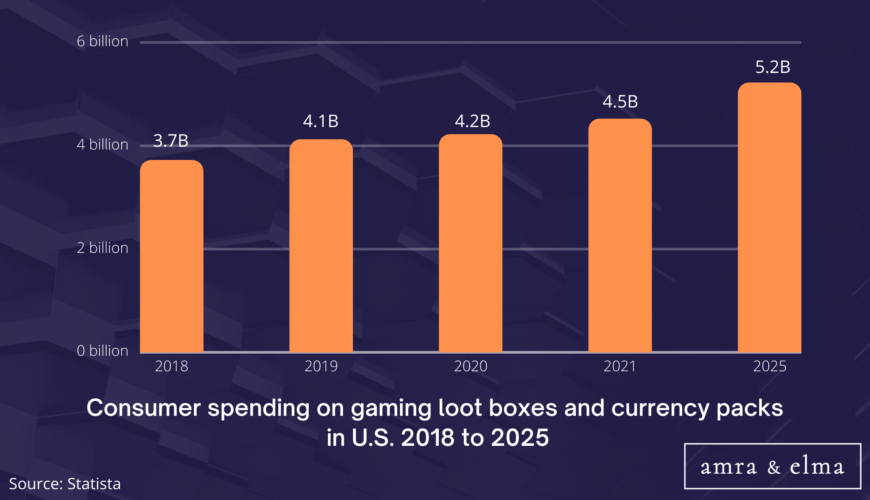
Gaming Marketing Statistics #11: The average yearly amount spent on games in North America is $243.
According to a report by Newzoo, the average amount spent by gamers in the Asia-Pacific region is $167. This is lower than the average yearly amount spent on games in North America, which is $243. The average amount spent on games or gaming content in Europe is also lower, at $131. These numbers show a significant difference in the amount of money gamers in different regions are willing to spend on their hobbies. This difference may be due to various factors, such as the cost of living in each region or the level of disposable income. Whatever the cause, it is clear that gaming is a passion for people worldwide and that gamers are willing to invest considerable sums of money in their hobby.
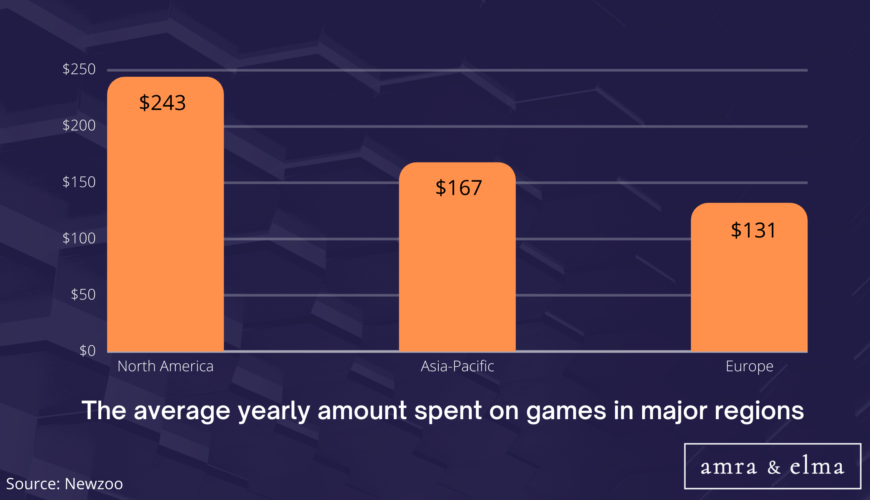
Gaming Marketing Statistics #12: 62% of gamers say they would be more likely to buy a product advertised within a game.
With the increasing popularity of gaming, corporations are taking notice of the potential for advertising within games. Moreover, with good reason – a recent study by Nielson found that 62% of gamers said they would be more likely to buy a product advertised within a game, and 77% said they would be more likely to try a new product. This presents a unique opportunity for businesses to reach a large and engaged audience. What is more, advertising in games can be highly effective, as it allows businesses to create custom-tailored messages that are delivered in a fun and interactive way. As the gaming industry continues to grow, we can expect to see more and more businesses taking advantage of this powerful marketing tool.
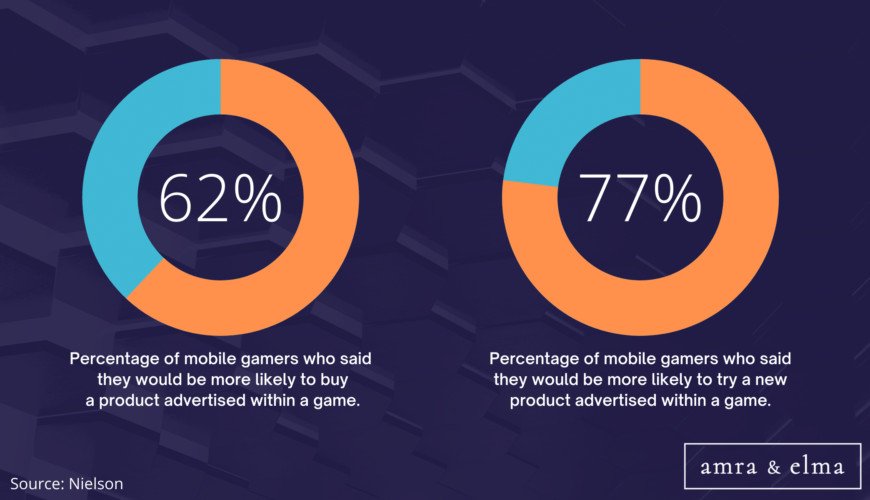
Gaming Marketing Statistics #13: Influencer marketing in games reached over $4.4 billion in 2022.
The gaming industry has seen an enormous boom in recent years, with the popularity of both casual and competitive gaming increasing exponentially. This has had a knock-on effect on influencer marketing, with an increasing number of brands looking to partner with gamers to reach this vast and engaged audience. According to Business Insider Intelligence, influencer marketing in games was worth $822 million in 2019, $2.5 billion in 2021, and it even reached over $4.4 billion in 2022. This growth is being driven by several factors, including the increasing number of people playing games, the rise of streaming platforms like Twitch, and the growing spending power of gamers.
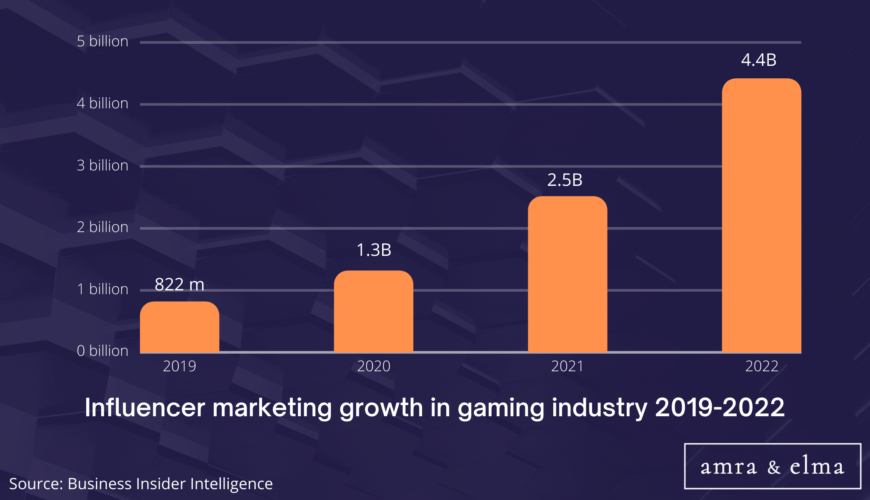
Gaming Marketing Statistics #14: Game publishers spent $11.9 billion on marketing in 2021.
Game publishers have been upping their marketing budgets in recent years, and it seems to be paying off. According to new report by Newzoo, in 2018, they spent $4.6 billion on marketing, up from $4.2 billion in 2017. This trend has continued to spike into 2021, with publishers spending $11.9 billion on marketing last year. This increase in spending is likely due to games’ growing popularity and competition among publishers. With more games on the market than ever before, publishers have to spend more to make their games stand out. Furthermore, with new platforms such as next-generation consoles and streaming services emerging, they also have to invest more in marketing to reach new audiences. Given the current trends, game publishers will likely continue to increase their marketing budgets in the years to come.
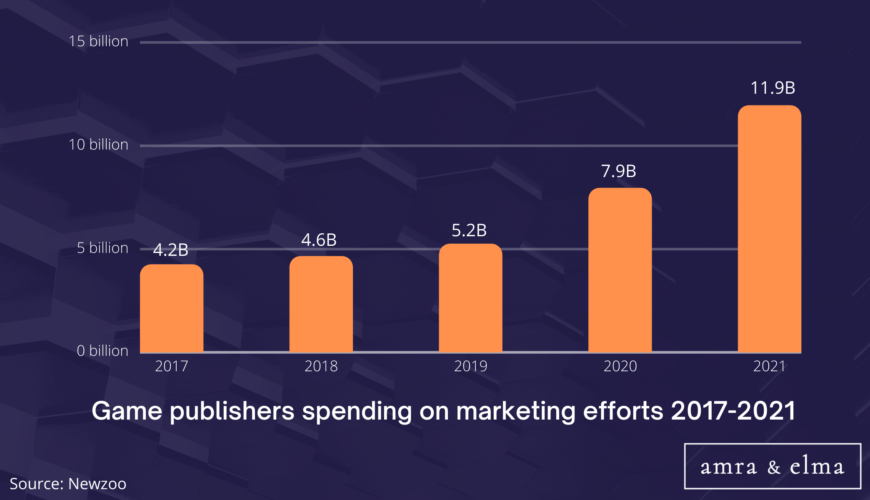
According to the latest data by Statista, in 2021, video game publisher Electronic Arts (EA) spent 689 million U.S. dollars on marketing and sales-related activities. This represents a 12 percent increase compared to the previous year. In 2020, the company spent 567 million U.S. dollars on these activities and 461 million U.S. dollars in 2019. EA significantly increased its promotional and advertising spending during the observed period, primarily on its FIFA franchise. The bulk of the company’s marketing and advertising expenses are dedicated to online channels such as social media, display advertising, and paid search. EA has also been investing in influencer marketing, eSports, and live events in recent years. These strategies have helped the company reach new audience segments and grow its overall sales. EA is well-positioned to continue its success in the coming year’s thanks to its strong marketing efforts.

Gaming Marketing Statistics #16: 81% of media buyers wanted to increase their in-game advertising spend over 2022.
A February 2022 report from in-play advertising platform Admix and Atomik Research shows that a vast majority of media buyers are looking to increase their in-game advertising spend in the next year. The report surveyed 500 media buyers and found that 81% of respondents said they wanted to increase their in-game ad spend over the year of 2022. This is a significant increase from the 64% who said they were planning to increase spending in a similar survey from Admix and Atomik Research conducted in 2022. The findings indicate that in-game advertising is becoming an increasingly important part of media buyers’ budgets as they look to reach consumers where they are spending more and more of their time. With the rapid growth of gaming and the continued rise of streaming services, it is clear that in-game advertising is here to stay and will only continue to grow in prominence.
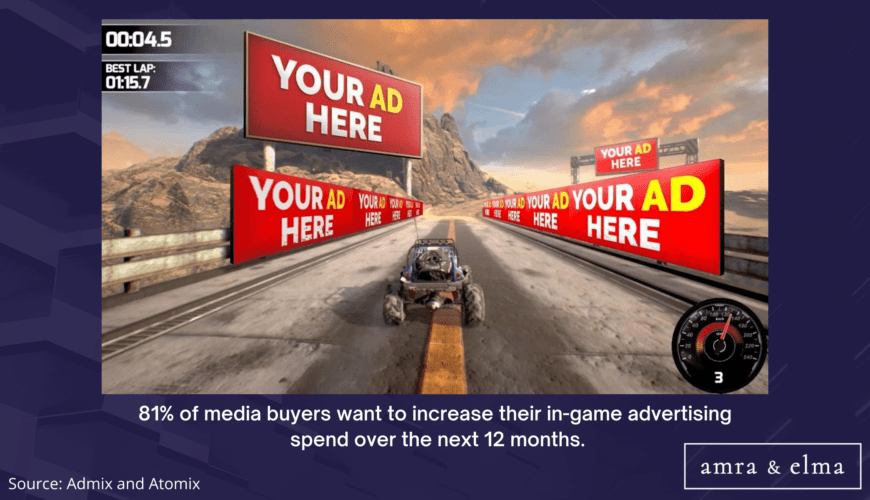
Gaming Marketing Statistics #17: 66% of game studios are currently making games for PC.
The results of the GDC study are in, and it appears that the majority of game studios are focusing their efforts on PC games. 66% of respondents said they were currently working on a PC game. This is not surprising, given the popularity of PC gaming and the wide range of platforms available. However, it is worth noting that 48% of studios are now working on VR/AR games. This is a relatively new market, and it will be interesting to see how it develops over the next few years. Almost 38% of studios work on mobile games for smartphones and tablets. This is a significant increase from previous years, indicating that mobile gaming is becoming increasingly popular. Finally, 31% of all studios develop a game for Playstation 5/Pro, while 28% work on an Xbox game. With the next generation of consoles just around the corner, many studios are already preparing their latest titles for release.
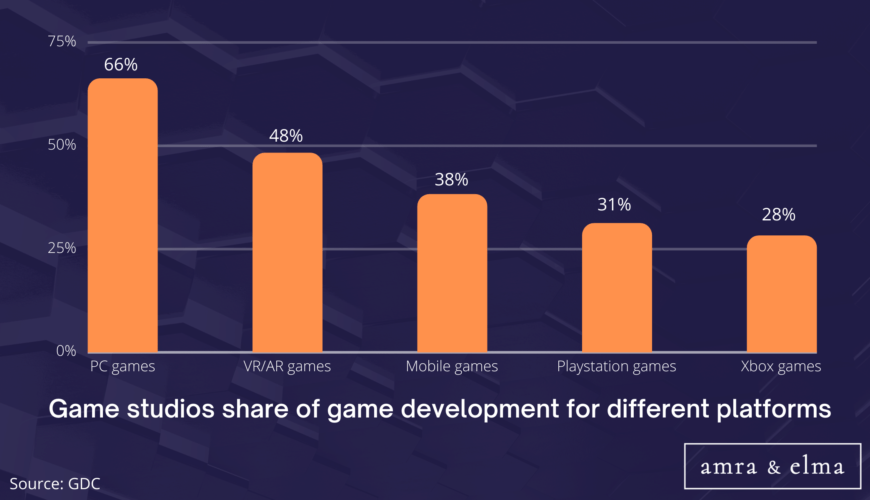
Gaming Marketing Statistics #18: 47% of game developers sell their games on Steam.
According to the GDC State of the Game Industry report, 47% of game developers sell their games on Steam. This is not surprising, given that Steam is the most prominent digital storefront for PC games, with over 125 million active users. However, many developers prefer to sell their games directly to customers, accounting for 26% of sales. This direct-to-customer model allows developers to keep a larger share of the revenue, but it also comes with some challenges. For example, developers need to build and maintain their own websites and handle customer support. In addition, many customers are still reluctant to purchase games directly from unknown developers, preferring the security of established storefronts like Steam. As a result, publishers’ storefronts like Battle.net account for a relatively small share of game sales, at 18%.
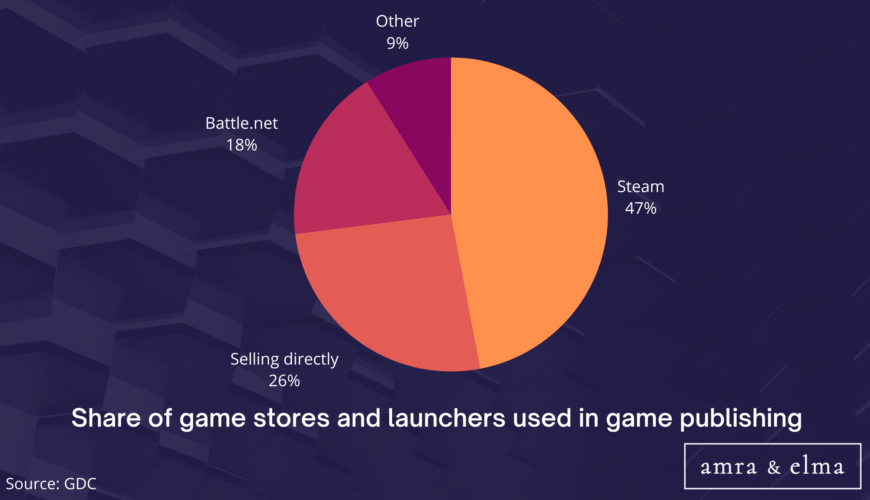
Gaming Marketing Statistics #19: 75% of industry experts said they anticipate the AR and VR market to surpass the traditional gaming market in revenue.
A Perkins Coie and XR Association survey of over 2600 professionals found that 75% of respondents said they anticipate the AR and VR market to surpass the traditional gaming market in revenue within the next five years. The survey also found that 64% of respondents believe augmented reality will significantly impact the gaming industry, followed by virtual reality at 61%. The survey indicates that AR and VR technology is becoming increasingly commonplace in the gaming industry and that its impact is expected to only grow in the years to come. Perkins Coie partner Joe Conley said, “The survey results show much excitement about the potential for AR and VR in gaming, and we expect to see more and more companies investing in this space.” Conley added that Perkins Coie sees ” a lot of activity” in the AR and VR space, with companies working on everything from new hardware to new applications and games. As the Perkins Coie survey shows, the gaming industry is on the cusp of a major shift, one that is likely to be driven by advances in AR and VR technology.

Gaming Marketing Statistics #20: Over 70% of video game workers claim their studios have no interest in integrating cryptocurrency payments or NFT mechanics into their games.
The latest State of the Game Industry survey by the Game Developers Conference (GDC) has revealed that over 70 percent of video game workers claim their studios have no interest in integrating cryptocurrency payments or NFT mechanics into their games. This is a significant increase from last year when only 58 percent of respondents said their studio was not interested in these technologies. The survey also found that only 5 percent of developers are currently working on projects that incorporate cryptocurrencies or NFTs. These findings suggest that most game developers are not yet convinced of the merits of integrating these technologies into their games. However, with the growing popularity of NFTs and cryptocurrencies, this could easily change in the future.
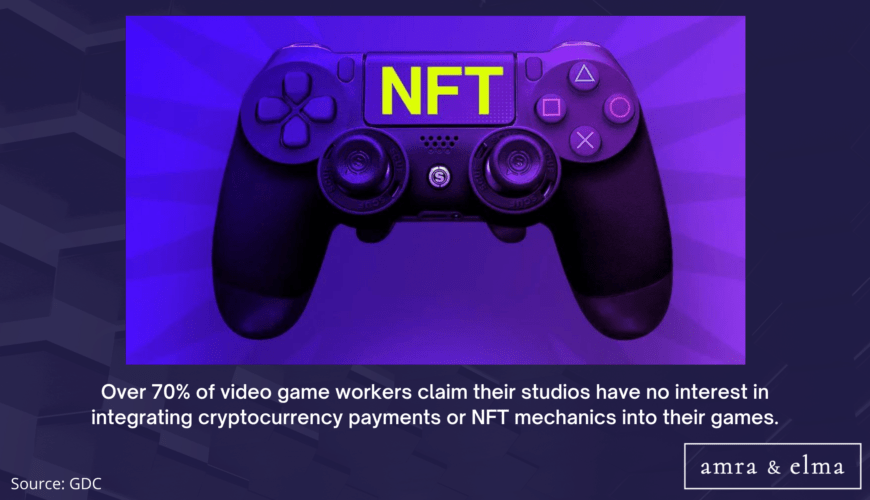
Gaming Marketing Statistics #21: The average CPM of mobile games in the U.S. exceeded $28.
According to PocketGamer, mobile games’ cost per mille (CPM) on the meta platform increased by 34 percent in 2021. The average CPM of mobile games in the U.S. exceeded $28, and this value equals a 93 percent increase over the average from 2020. CPM is the cost an advertiser pays to have their ad shown 1,000 times. The increase in ad spending prices is likely due to the Covid-19 pandemic, as people turned to their phones for entertainment while stuck at home. It is also a sign that marketers see more value in advertising on mobile games than on other platforms. For example, the CPM for video ads on Facebook decreased by 13 percent during the same period. As people spend more time playing mobile games, we can expect even more money to be funneled into this already booming industry.

Gaming Marketing Statistics #22: Mobile gaming gender statistics show that 7.5% of women who play mobile games pay for the in-app game content, compared to 6.3% of men.
The mobile gaming industry is booming, and women are leading the charge when paying for in-app content. According to Mordor Intelligence report, the 75th percentile 30-day user retention improved by 7.1% from 2016 to 2020, and conversion rates for in-app purchases grew by around 7.7% in the same period. Mobile gaming gender statistics show that 7.5% of women who play mobile games pay for the in-app game content, compared to 6.3% of men. This indicates that women are more engaged with mobile gaming and more likely to spend money on in-game content. With the mobile gaming industry continuing to grow rapidly, it is clear that women will continue to be a significant force in the market.
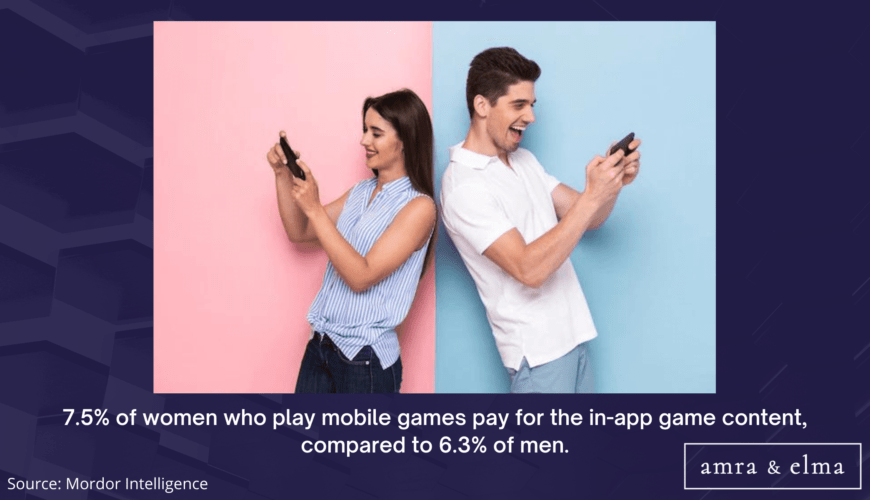
Gaming Marketing Statistics #23: In 2021, women accounted for 45% of gamers in the United States.
According to the U.S. video gaming audiences report by Statista, in 2021, women accounted for 45 percent of gamers in the United States, up from 41 percent of U.S. gamers identifying as women during the previous year. The report states that the number of women gamers has been steadily increasing over the past few years, and this trend is expected to continue in the future. Several factors could be driving this increase, including the growing popularity of mobile and casual games, the rise of female-led game development studios, and the number of women streaming their gameplay on platforms like Twitch and YouTube. Whatever the reasons, it is clear that women are increasingly becoming a force to be reckoned with in the gaming world.
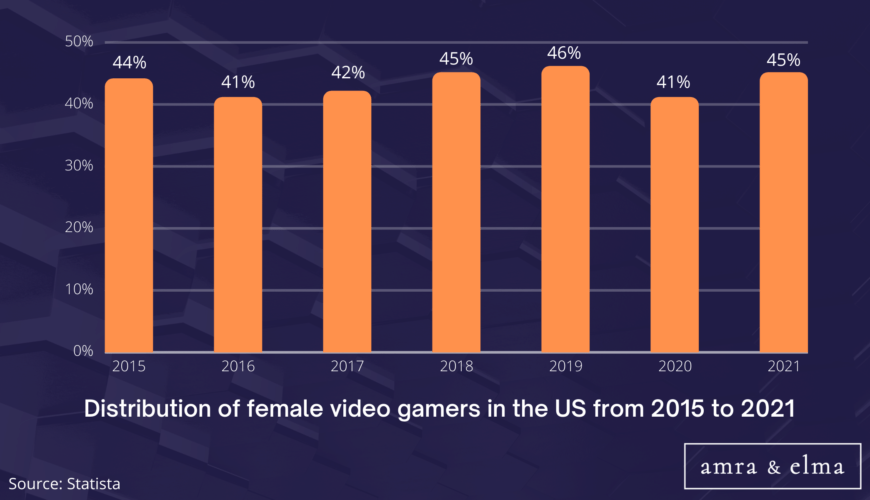
Gaming Marketing Statistics #24: The number of worldwide gamers surpassed 3 billion in 2022.
According to the latest eMarketer report, in 2022, a resounding 2.96 billion people worldwide played digital games, whether via console, computer, or mobile device. That figure is surpassed 3 billion in 2022. That is a lot of goals scored, blocks mined, and quests completed. By comparison, the global population stands at just over 7.9 billion—meaning that gamers will make up more than a third of the world’s population. It is easy to see why gaming has become such a phenomenon: it is fun, it is social (both in-person and online), it can be competitive, it can be relaxing, and—perhaps most importantly— it is always available ( thanks to the growth of mobile gaming). Whether people are looking to while away a few minutes on their daily commute or kill an entire afternoon on their couch, there is a game out there for everyone —and more than 2.9 billion other people.
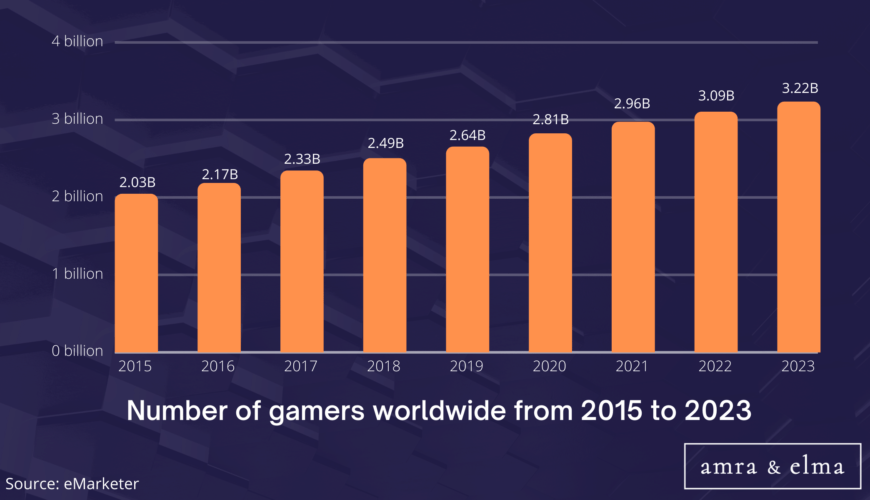
Gaming Marketing Statistics #25: Gamescom is the biggest video game convention in terms of attendees.
According to the data by Statista, Gamescom is the biggest video game convention in terms of attendees. Its 2019 edition saw 373,000 entries over four days, reflecting the status of Germany as the fifth-biggest market for video games despite its national industry lagging in terms of output and revenue. Gamescom is closely followed by the China Digital Entertainment Expo & Conference, or ChinaJoy, which attracted 365,000 visitors in 2019 and had its inaugural four-day run in 2004. According to data by Newzoo, China was the biggest video game market in the world in 2021, with revenues of roughly $41 billion, most of which were generated by mobile games. The United States was ranked second with revenues of $36.9 billion, followed by Japan ($19.2 billion), South Korea ($6.7 billion), and Germany ($3.6 billion). As the global video game industry grows, Gamescom will likely maintain its position as the world’s largest gaming convention.

The Future of Gaming Marketing
These essential gaming marketing statistics provide insights into the current state of the gaming industry and where it is headed. As the gaming industry grows, so does the importance of understanding these gaming marketing statistics. The reason for this is that the gaming industry is growing at a rapid pace and is expected to reach $200 billion by 2023. This means that marketers have more opportunities to reach gamers with their products and services. In addition, the gaming population is becoming more diverse, with women and older adults now playing video games. This means that marketers need to be aware of the different demographics of gamers to target them effectively.
The gaming industry is also becoming more social, with platforms such as Twitch and Discord allowing gamers to interact with each other. This presents an opportunity for marketers to create sponsored content and engage with gamers directly. Finally, the rise of mobile gaming means that marketers can reach gamers wherever they are. With all of these factors considered, it is clear that gaming marketing statistics will continue to be essential for marketers in the years to come.
TOP GAMING MARKETING STATISTICS IN 2023- FAQ:
How big is the gaming market?
The Gaming Market was valued at USD 198.40 billion in 2021, and it is expected to reach a value of USD 339.95 billion by 2027, registering a CAGR of 8.94% over 2022-2027.
What are the statistics of gaming?
Statistics of gaming are showing a huge growth of the marketing industry. According to app usage statistics, both males and females spend more than 60 minutes playing a game on their mobile phones on a daily basis.
Who dominates the video game market?
Video game market is being dominated by Sony in 2022 and previous years as well. The Japanese tech giant now makes most of its gaming revenue, which totaled $24.9 billion last year, with the PlayStation 5 which came out in 2020 and became the world’s most popular next-gen video game console.
What are the demographics of gamers?
The current demographic for video games is dominated by people aged 18–34, with 38% of players. Other large groups are people under 18, with 20%, and 35–44 year-olds, with 14%. Of all gamers, 55% of the gamers are male, while 45% are women. The numbers are country-dependent, but this is a general average.
What is gaming marketing?
Gaming marketing is the process of advertising and promoting video games to consumers. Gaming marketing encompasses a variety of marketing activities, such as advertising, public relations, event marketing, and community management. Gaming marketing is important because it helps to create awareness and excitement for video games among consumers. Gaming marketing can also help to boost sales and encourage people to play more games.
There are various ways that marketers in the gaming marketing industry can promote video games. One common approach is to run television commercials or online ads. Gaming marketers in the gaming marketing industry can also work with popular YouTube personalities to create promotional videos. Additionally, they can hold events such as gaming tournaments or game launches to generate excitement among consumers. Gaming marketers in the gaming marketing sector can also use social media platforms such as Twitter and Facebook to engage with gamers and promote their games.
Why is gaming marketing so popular?
Gaming marketing is popular because it is an effective way to reach a large and engaged audience. Gaming is a popular pastime, and gaming marketing campaigns targeting gamers can be highly successful. Additionally, gaming marketing provides an immersive experience that is perfect for marketing products and services. Gamers are often passionate about their hobby, and they are more likely to respond to marketing messages that are relevant to their interests. Additionally, gaming marketing provides an opportunity to connect with customers on a personal level. Gamers are more likely to trust brands that they feel have a shared interest in gaming. In short, gaming marketing is popular because it is an effective way to reach a large and engaged audience, and it provides opportunities for deep engagement with customers.
Why is gaming marketing important for the gaming industry?
Gaming marketing is one of the most important aspects of the gaming industry. Without gaming marketing, companies would have a much harder time reaching their target markets and promoting their products. Gaming marketing is so important that it can be argued that it is the most essential part of the gaming industry.
There are several reasons why gaming marketing is so important. First and foremost, gaming marketing allows companies to reach their target markets more effectively. By creating targeted advertising campaigns and using specific marketing strategies, companies can better communicate with their target audiences and ensure that their products are seen by the right people. Additionally, gaming marketing helps to create awareness for new games and consoles, which can help to boost sales.
Furthermore, gaming marketing can also be used to build hype for upcoming games and consoles. By generating excitement among gamers, many companies in the gaming marketing industry can create a sense of anticipation that can lead to increased sales once the game or console is released. In short, gaming marketing is an essential tool for promoting games and consoles, and it plays a critical role in the success of the gaming industry.
What is gaming influencer marketing?
Gaming influencer marketing is a form of marketing whereby brands collaborate with gaming influencers to reach target audiences and promote their products or services. Gaming influencers possess a significant following on social media platforms such as YouTube, Twitter, and Twitch. They are sought after by companies looking to leverage their popularity to increase brand awareness and drive sales.
Through gaming influencer marketing, brands can leverage the influencers’ social media following to promote their products, with the influencers creating engaging content that appeals to their audience while still featuring the brand’s products. Gaming influencers can showcase the brand’s products through reviews, tutorials, gameplay, or behind-the-scenes footage, making the promotion appear more natural and organic, ultimately leading to better audience engagement.
Gaming influencer marketing is a unique marketing strategy because it allows brands to target niche audiences more likely to be interested in their products and services. Additionally, gaming influencer marketing enables brands to track their return on investment more effectively by working with gaming influencers who can provide detailed analytics of their social media following, reach, and engagement rates.
In conclusion, gaming influencer marketing has proven to be a valuable marketing strategy to help brands increase their reach and engage with their target audience effectively. The growing popularity of gaming and the rise of social media has made it possible for brands to collaborate with gaming influencers to promote their products in a way that feels authentic and relatable to their target audience. Gaming influencer marketing has undoubtedly contributed to the growth of the gaming industry and will continue to do so in the future.
What is the future of gaming influencer marketing?
Gaming influencer marketing has emerged as an effective way of promoting games and engaging audiences. As the gaming industry continues to grow, influencer marketing for gaming is becoming increasingly important. The future of gaming influencer marketing holds immense potential in terms of growth and innovation.
In the current digital marketing era, gaming influencer marketing is gaining traction as an effective way to promote games. According to a recent survey about gaming influencer marketing, 82% of gamers have admitted to watching gaming content on YouTube, Twitch, and other platforms. This massive audience gives game publishers and developers a huge opportunity to increase their reach and engagement among gamers.
One of the trends that we can expect in the future of gaming influencer marketing is the rise of micro-influencers. Micro-influencers are social media influencers with a relatively minor following but higher engagement rates. These influencers can offer a more personalized experience for followers. They can be cost-effective for game publishers who wish to work with them.
Another trend likely to emerge is the integration of gaming influencer marketing. As gaming platforms expand and evolve, they may offer unique influencer sponsorships. This sponsorship can include in-game items, tournaments, and even exclusive access to unreleased games.
The rise of gaming influencers has already led to the development of e-sports as a lucrative industry. E-sports tournaments have attracted millions of viewers, and gaming influencers have significantly promoted these events. As the gaming industry and e-sports continue to grow, the role of gaming influencer marketing will continue to rise.
In conclusion, the future of gaming influencer marketing holds immense potential for growth and innovation. As gaming platforms, technology, and the audience grows, game publishers and developers will likely rely more on gaming influencers to promote their games. However, as the industry evolves, transparency, authenticity, and ethical standards will become increasingly crucial for gaming influencer marketing.

